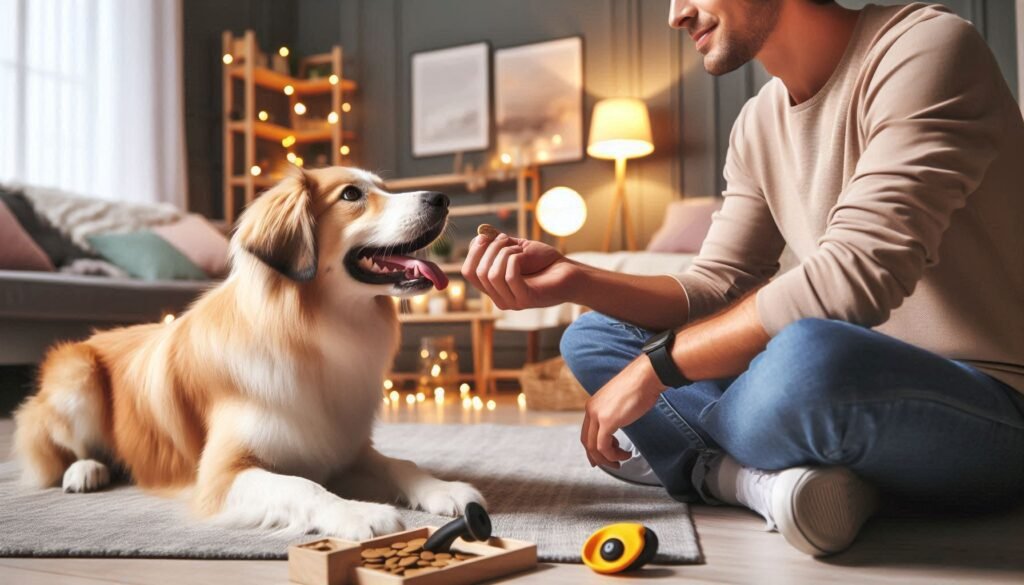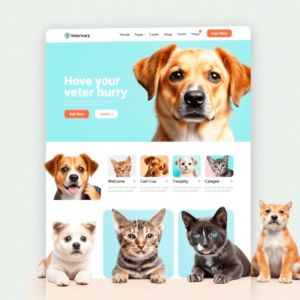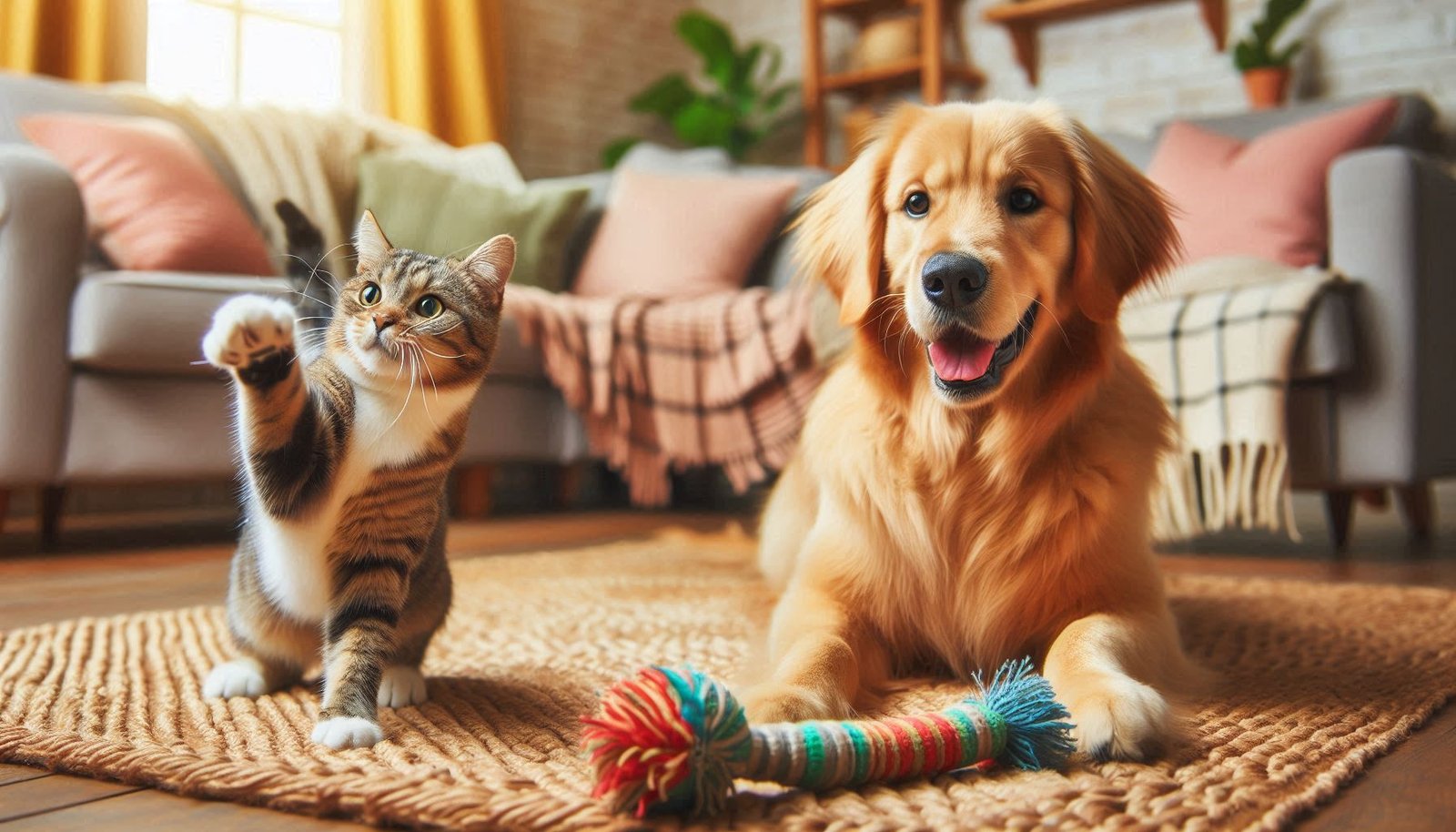Introduction
Proper training for pets is not just a luxury; it’s an essential part of being a responsible pet owner. Understanding how dogs behave and using the best techniques for training can greatly improve your dog’s behavior, creating a peaceful home. Effective training not only stops unwanted actions but also strengthens the bond between you and your furry friend, leading to a relationship based on trust and respect.
In this article, we will explore 10 effective tactics for pet training that have proven to work. These strategies include:
- Positive Reinforcement: Rewarding good behavior with treats, praise, or play.
- Consistency: Using the same commands and signals to help dogs understand expectations.
- Short Sessions: Keeping training brief to maintain your dog’s attention.
- Integrating Training into Daily Life: Making every moment a learning opportunity.
- Hand Signals: Enhancing communication with visual cues.
- Socialization: Exposing puppies to various environments during critical developmental periods.
- Clicker Training: Using a clicker to mark desired behaviors.
- Model-Rival/Mirror Training: Letting dogs learn by observing others.
- Relationship-Based Training: Fostering trust and communication over dominance.
- Enrichment Activities: Providing mentally stimulating activities to promote cognitive development.
These tactics are designed to be practical, engaging, and effective, ensuring that both you and your pet enjoy the training process. Let’s dive deeper into each approach to discover how they can transform your pet’s behavior and enrich your lives together.
1. Positive Reinforcement Techniques
Positive reinforcement is the foundation of effective dog training, using rewards to encourage desired behavior. Instead of punishing your dog, this method focuses on promoting good habits by offering something they value.
Examples of Training Rewards:
- Treats: Use small, tasty treats that your dog loves to reward them for good behavior.
- Praise: Offer verbal praise or gentle petting to show your dog that they did well.
- Playtime: Incorporate their favorite game or toy as a reward to reinforce positive actions and strengthen your bond.
By consistently using these reward-based methods, you create an environment where your dog is eager to learn and respond positively to training sessions.
2. Consistency is Key
Consistency in dog training is essential for effective communication. Dogs thrive on routine and clear expectations. When commands and signals are consistent, they can understand what is expected of them, reducing confusion and fostering quicker learning.
1. Same Words for Commands
Always use the same word for each command. For example, “sit” should always be “sit,” not “sit down” or “please sit.” This uniformity helps your dog associate specific words with specific actions.
2. Consistent Gestures
Pair verbal commands with consistent hand signals. If you use a certain gesture for “stay,” ensure it remains unchanged every time you give that command.
3. Routine Practice
Incorporate training into daily routines to reinforce learning in various settings. Practicing basic commands during walks or playtime ensures your dog understands them in different environments.
4. Unified Approach
Ensure all family members use the same commands and signals. Mixed messages can confuse your dog, hindering their training progress.
By maintaining consistency, you pave the way for a well-trained dog who understands and responds accurately to your cues, enhancing both obedience and your bond.
3. Keeping Training Sessions Short and Fun
Short training sessions are essential for maintaining your dog’s focus and enthusiasm. Limiting sessions to 5-10 minutes helps prevent frustration and keeps both you and your pet engaged.
Tips for Effective Dog Training
- Incorporate Playtime: Blend training with brief play intervals to keep things lively.
- Use Interactive Toys: Engage your dog with toys that stimulate their mind while reinforcing commands.
By keeping things brief and enjoyable, you’ll see more effective results, ensuring a happy and well-trained pet.
4. Integrating Training into Daily Life Routine
Integrating training into everyday activities transforms mundane moments into valuable learning opportunities. Here are ways to seamlessly blend training exercises with your daily routines:
- During Walks: Practice commands such as “sit,” “stay,” or “heel” while out for a walk. These sessions not only reinforce obedience but also improve your dog’s behavior in different environments.
- Mealtimes: Use mealtimes as a chance to practice patience and impulse control by teaching commands like “wait” before allowing your dog to eat.
- Playtime: Incorporate training commands during play, such as asking your dog to “drop it” or “fetch.” This makes learning enjoyable and reinforces positive behaviors.
Consistent practice across various settings helps solidify your dog’s understanding and responsiveness, ensuring that training is both effective and fun.
5. Utilizing Hand Signals Alongside Verbal Commands
Incorporating hand signals for dogs along with verbal commands enhances communication clarity and strengthens the training process. Visual cues can be particularly helpful for dogs that are hearing-impaired or in noisy environments where verbal commands might be missed.
Advantages:
- Clear Communication: Dogs often respond better to visual stimuli.
- Versatility: Useful in situations where verbal commands are impractical.
- Enhanced Focus: Combining signals engages multiple senses, reinforcing learning.
Effective Hand Signals:
- Sit: Raise your palm upward.
- Stay: Show your palm facing the dog.
- Come: Sweep your hand toward yourself.
- Down: Point to the ground.
These signals, when paired consistently with verbal cues, create a robust and reliable communication framework.
6. The Power of Socialization During Critical Developmental Periods
Understanding dog behavior begins with socialization in puppies. This critical phase, occurring between 8-20 weeks, shapes a puppy’s long-term adaptability and behavior. Early exposure to various people, animals, and environments is essential. Puppies that are well-socialized during this period tend to be more confident and less prone to anxiety and aggression.
Effective Tips for Socializing Your Puppy:
- Introduce Gradually: Start with controlled environments before moving to busier settings.
- Positive Experiences: Pair new experiences with treats or praise to create positive associations.
- Variety is Key: Expose your puppy to different sounds, sights, and textures.
- Safe Encounters: Ensure interactions with other dogs and people are calm and supervised.
- Regular Playdates: Arrange play sessions with well-behaved dogs.
Socialization not only enhances your puppy’s confidence but also builds a foundation for a well-adjusted adult dog.
7. Clicker Training Method: A Step-by-Step Guide
The clicker training technique is a game-changer in pet training. It works by using a distinct click sound to mark the behaviors you want to encourage in your dog. This method helps bridge the communication gap between you and your furry friend, making it easier for them to understand what you want.
Benefits of Clicker Training
- Instant Feedback: The click sound precisely marks the moment of the desired behavior.
- Consistent Communication: Clear signals reduce confusion, enhancing learning speed.
- Positive Reinforcement: Encourages desired behaviors without punishment.
Getting Started with Clicker Training at Home
- Acquire a Clicker: Easily found at pet stores.
- Condition Your Dog to the Clicker:
- Click, then immediately offer a treat.
- Repeat until your dog associates the click with a reward.
- Introduce Commands:
- Issue a command (e.g., “sit”).
- Click the moment your dog performs the action.
- Reward promptly after the click.
- Practice Regularly:
- Short, frequent sessions ensure sustained interest and better retention.
Unlocking your dog’s potential through this structured approach fosters an environment of mutual understanding and enjoyment.
8. Exploring Different Training Approaches: Model-Rival/Mirror Training Method Explained
The model-rival/mirror training approach uses the power of observation, allowing dogs to learn by watching others being rewarded for specific behaviors. This method takes advantage of a dog’s natural tendency to mimic and compete, making it an effective tool for behavioral training.
How It Works:
- Observation: Dogs observe a model (human or another dog) performing a desired behavior.
- Reward: The model receives a reward for the correct behavior.
- Imitation and Competition: The observing dog, motivated by both imitation and rivalry, attempts to replicate the behavior to earn similar rewards.
Practical Applications:
- Teaching Tricks: Show your dog how another pet earns treats by performing tricks, encouraging them to try it themselves.
- Good Manners: Use well-behaved dogs as models during socialization activities, helping your pet learn appropriate behaviors in various settings.
This observational learning technique enriches training sessions with interactive and engaging experiences, driving home lessons through real-time examples.
9. Building a Strong Relationship-Based Training Foundation With Your Dog
Building trust, communication, and mutual respect with your furry friend is the foundation of effective training. Instead of using dominance or punishment techniques, a relationship-based approach to dog training focuses on creating a strong bond between you and your pet.
Key Elements of Relationship-Based Training:
- Trust: Create an environment where your dog feels safe and valued.
- Communication: Use clear, consistent signals to convey expectations.
- Respect: Understand and respond to your dog’s needs and emotions.
This approach leads to better overall behavior in pets. Dogs trained with respect and patience tend to be more obedient, less anxious, and more eager to please their owners. It not only improves learning but also strengthens the emotional connection between you and your dog, making the training process enjoyable for both of you.
10. Enhancing Learning Experiences Through Enrichment Activities For Dogs
Enrichment activities for pets’ mental stimulation are crucial for fostering cognitive development and preventing boredom. These activities engage your dog’s mind, making them happier and more balanced.
Types of Enrichment Activities:
- Puzzle Toys: These toys challenge your dog to think and solve problems to receive a reward. Examples include treat-dispensing puzzles and interactive feeders.
- Interactive Games: Games like fetch, tug-of-war, and hide-and-seek not only provide physical exercise but also stimulate mental agility.
- Scent Work: Hide treats around the house or yard and encourage your dog to use their nose to find them. This taps into their natural hunting instincts.
Incorporating Enrichment into Daily Routine:
- Rotate toys to keep them novel and interesting.
- Schedule short sessions throughout the day rather than overwhelming your dog with long periods of activity.
- Use mealtime as an enrichment opportunity by feeding them through puzzle feeders or using treat-dispensing toys.
Implementing these strategies ensures that your dog remains mentally stimulated, leading to enhanced learning experiences and better overall behavior.
Conclusion
By consistently and patiently applying these pet training best practices, you will see amazing results over time. Each method, from using positive reinforcement to engaging in enrichment activities, plays a part in a comprehensive strategy that supports your dog’s growth and strengthens your relationship.
Feel free to try out these methods at home. Keep in mind that every dog is different; it’s important to understand their unique learning speed and preferences. Adjust the techniques to meet your furry friend’s requirements and see them flourish.
If you’re looking for personalized assistance or dealing with specific training difficulties, think about scheduling a session with a skilled trainer. Their professional knowledge can provide customized solutions that improve your pet’s training experience.








